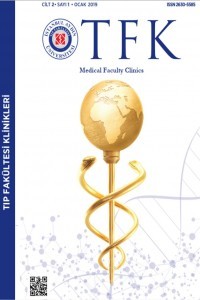Atipik Bir Parasantral Akut Orta Makulopati Olgusu
Hipoksi, Retina, Makülopati
Atypical Paracentral Acute Middle Maculopathy: A Case Report
Hypoxia, Retina, Maculopathy,
___
- Moura-Coelho N, Gaspar T, Joana TF. Paracentral acute middle maculopathyreview of the literature. Graefes Arch Clin Exp Ophthalmol 2020;258, 2583-2596.
- Bos PJ, Deutman AF. Acute macular neuroretinopathy. Am J Ophthalmol 1975;80(4):573- 584.
- Chu S, Nesper PL, Soetikno BT, Bakri SJ et al. Projection-resolved OCT angiography of microvascular changes in paracentral acute middle maculopathy and acute macular neuroretinopathy. Investig Ophthalmol Vis Sci 2018;59(7):2913– 2922.
- McLeod D. Misery perfusion, diffusive oxygen shunting and interarterial watershed infarction underlie oxygenationbased hypoperfusion maculopathy. Am J Ophthalmol 2019;205:153-164.
- Pichi F, Fragiotta S, Freund KB, Au A et al. Cilioretinal artery hypoperfusion and its association with paracentral acute middle maculopathy. Br J Ophthalmol 2019;103(8):1137-1145.
- Christenbury JG, Klufas MA, Sauer TC, Sarraf D. OCT angiography of paracentral acute middle maculopathy associated with central retinal artery occlusion and deep capillary ischemia. Ophthalmic Surg Lasers Imaging Retin 2015;46(5):579–581.
- Rahimy E, Kuehlewein L, Sadda SR, Sarraf D. Paracentral acute middle maculopathy: what we knew then and what we know now. Retina. 2015;35:1921-1930
- Casalino G, Williams M, McAvoy C, Bandello F et al. Optical coherence tomography angiography in paracentral acute middle maculopathy secondary to central retinal vein occlusion. Eye 2016;30(6):888-893.
- Shah A, Rishi P, Chendilnathan C, Kumari S. OCT angiography features of paracentral acute middle maculopathy. Indian J Ophthalmol 2019;67(3):417-419.
- El-Dairi M, Bhatti MT, Vaphiades MS. A shot of adrenaline. Surv Ophthalmol 2009;54:618-624.
- Yu S, Wang F, Pang CE, Yannuzzi LA et al. Multimodal imaging findings in retinal deep capillary ischemia. Retina. 2014;34:636-646.
- Rahimy E, Kuehlewein L, Sadda SR, Sarraf D. Paracentral acute middle maculopathy: what we knew then and what we know now. Retina 2015;35:1921-30.
- Nemiroff J, Phasukkijwatana N, Sarraf D. Optical coherence tomography angiography of deep capillary ischemia Dev Ophthalmol 2016;56:139-145.
- Kerrison JB, Pollock SC, Biousse V, Newman N. Coffee and doughnut maculopathy: a cause of acute central ring scotomas. Br J Ophthalmol 2000;84:158- 164.
- Ishibashi K, Yatsuka H, Haruta M, Kimoto K et al. Branch retinal artery occlusions, paracentral acute middle maculopathy and acute macular neuroretinopathy after covid-19 vaccinations. Clin Ophthalmol 2022;31;16:987-992.
- ISSN: 2630-5585
- Başlangıç: 2018
- Yayıncı: İstanbul Aydın Üniversitesi
COVID-19 PANDEMİSİNDE SAĞLIK ÇALIŞANLARININ SÜPER BESİN ALGISI: KIRIKKALE İLİ ÖRNEĞİ
Özlem YILDIRIM UĞURLU, Özlem ÖZER ALTUNDAĞ
Adli Olgularda Örneklerin Tekrar Çalışılmasının Önemi: 3 Vaka Örneği
Atipik Bir Parasantral Akut Orta Makulopati Olgusu
Aygen YAMAN, Burak TURGUT, Shirin FOROUGHIFAR, Cansu ÖZCAN
Aylin DAĞ GÜZEL, Yesim TOK, Okan Kadir NOHUT, Seda SALMAN YILMAZ, Özge ALTINOK, Mert KUSKUCU, Kenan MİDİLLİ
Humerus, Radius ve Ulna’daki Foramen Nutricium’ların Sayı ve Lokalizasyonlarının İncelenmesi
